Inside the star-studded resort hiding in the middle of Utah’s nowhere
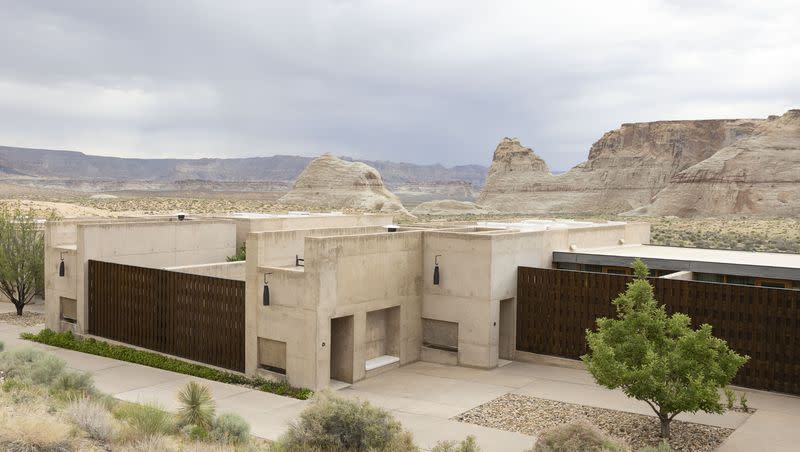
- Oops!Something went wrong.Please try again later.
- Oops!Something went wrong.Please try again later.
- Oops!Something went wrong.Please try again later.
- Oops!Something went wrong.Please try again later.
- Oops!Something went wrong.Please try again later.
Lady Gaga has danced in the kitchen here.
Miley Cyrus, Kylie Jenner, Kim Kardashian, Kanye West, Ariana Grande, Brad Pitt, Angelina Jolie and other A-list celebrities have all reportedly stayed here, in what’s been dubbed one of the most star-studded hotels in the world. Recently, former Miss Universe Olivia Culpo and San Francisco 49ers running back Christian McCaffrey got engaged here.
And those are just the names that have appeared in media reports or social media posts. There could be many more that don’t want the attention. The staff is sworn to secrecy.
One of the world’s most expensive and exclusive resorts is located in Utah — but it’s not where you might think. Perhaps you’d guess the ski mecca of Park City, home to the Sundance Film Festival, which does indeed attract a fair share of celebrities each year.
But no. The resort that has caught the ultrarich eye is far more remote, mysterious and, frankly, strange.
Its clientele is so elite that, oddly enough, it’s more well-known among global circles than in its own state. Many Utahns don’t know it exists — though perhaps more do nowadays due to its surging popularity with influencers and a recent visit by Eugene Levy for his show, “The Reluctant Traveler.”
Related
Getting here is no easy task. It’s more than 380 miles and six hours from Salt Lake City International Airport, tucked away on the far edges of Utah’s southern desert. Harry Reid International Airport in Las Vegas is an over four-hour drive away. Guests can also fly commercially into Page Municipal Airport (those who can afford it can charter a private jet there), some 25 minutes south of the resort.
As for me? I drove from the Salt Lake area and stayed a night in Kanab before driving another hour the rest of the way. It would be only a day visit. Rooms in May started at around $4,200 a night for the cheapest suite (rates fluctuate seasonally). I couldn’t fathom spending even one night at that price.
Even when you’re practically at its doorstep, after you pass through an unassuming metal gate and wind your way through dramatic desert canyons, hoodoos and towering plateaus, the resort is almost indiscernible. It hides in the rock, blending into the landscape that inspires all aspects of its design.
At first, its beige concrete walls seem bland, even anticlimactic. But then you walk up a set of stairs toward the lobby, you’re hit with a fresh breeze filled with the resort’s proprietary sweet yet herbal scent, and walls direct you to a spectacular, sweeping view of vast desert beyond.
This is Amangiri.
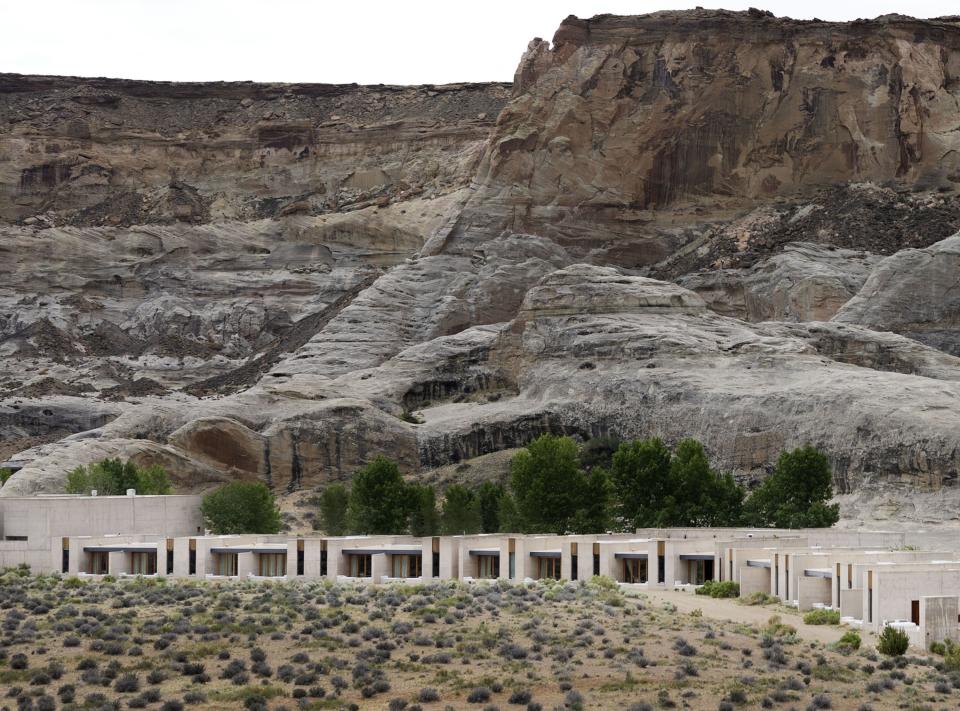
Owned by the multinational luxury hospitality giant Aman Resorts, Amangiri means “peaceful mountain” in Sanskrit. The five-star hotel in Canyon Point is a labyrinth-like architectural work of art that’s marketed as secluded, serene and silent. It showcases grand views of the Grand Staircase-Escalante National Monument and celebrates the culture of the nearby Navajo Nation.
In his TV show, Levy described Amangiri’s setting as “alien” — and even for a Utahn who grew up in the desert, taking yearly family trips to nearby Lake Powell, I’d agree. But it’s not the land that was alien to me. Everything else was.
The resort is stunning and bizarre. Minimalistic but also extravagant. It’s difficult to describe. But imagine a place where every texture and color — from the smooth stone walls to soft, sand-hued linens — complement the real star of the show, which is the landscape. Where time slows down, and you quickly learn to rise with the sun because the harsh, hot desert is most beautiful and welcoming during its still, brisk mornings.
To Homi Vazifdar, Amangiri’s founder, one can’t quite grasp the “ethos” of Aman without experiencing it.
“Envision a sort of a funnel, and you put the location, you put the brand, you put the design, and you put certain things that you really cannot articulate, and what comes out at the other end is close to a perfect product. And that’s the ethos.”
Why would people spend thousands of dollars a night to stay in the middle of nowhere? And how did one of the world’s most luxurious resorts end up in southern Utah, of all places?
I came to find out.

How did Amangiri come to Utah?
Made possible through an act of Congress and a president’s signature, Amangiri’s past is almost as remarkable as its present.
When Vazifdar and I chatted on a Zoom call ahead of my visit to Amangiri, he gave what he admitted was a “weird answer” when I asked how often he visits the resort he helped build.
“For the first five years, maybe, after it opened (in 2009), I couldn’t stand to go there,” Vazifdar said, “because it was such a difficult project.”
The co-founder of Canyon Group, a private equity company based in California that owns and develops ultraluxury resorts in exotic destinations across the world, became visibly exasperated when recalling the challenge that was developing Amangiri.
“It was a nightmare,” he said.
Everything was difficult, from trucking building materials and construction workers to the extremely remote site and “trying to educate local authorities who had never, ever seen a resort of this magnitude,” Vazifdar said. With an initial investment of more than $80 million, it was the most expensive project ever in Kane County, population 7,992.
“It just completely freaked people out,” he said.
During construction there were “problems with contractors, problems with vendors, problems with the architects,” he said, joking that he had hair before embarking on the project, gesturing toward his balding head.
“We had very, very talented architects, but they were very hard to deal with and we had to terminate a lot of people,” he said. “(We) constantly reinvented ourselves as we went through the process.”
From creative differences to cracking concrete, Vazifdar said Amangiri was a labor of passion but also aggravation from day one.
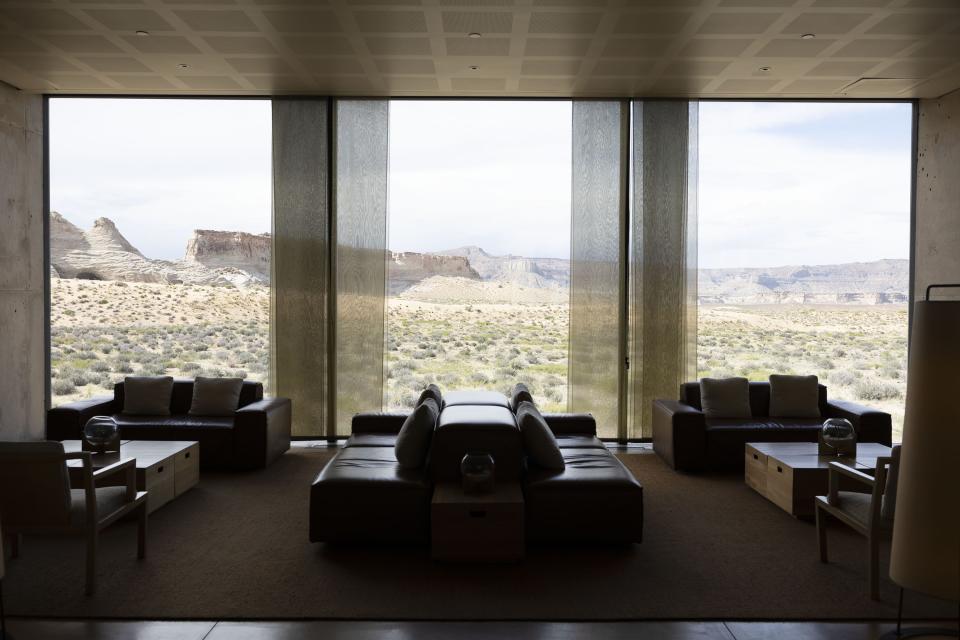
“A lot of people put their heart and soul into the execution of this project,” he said. “And there were a lot of investors who had faith in us. And that’s how it got done.”
Some of the biggest challenges came even before Amangiri’s groundbreaking.
Vazifdar said it all started over 20 years ago, with a cold call from Christoph Henkel, a London-based German billionaire businessman. He was passionate about Utah’s canyon country and had recently acquired hundreds of acres near Lake Powell. At the time, Vazifdar said he didn’t know anything about Lake Powell, but he decided to tour the site.
It was east of U.S. 89, near Big Water. Vazifdar said he was impressed, describing it as a “miniaturized Grand Canyon.” But the isolated land would prove challenging, and he knew only one man would be able to successfully develop it: his friend Adrian Zecha, founder of Aman Resorts. Vazifdar urged Zecha and his partner, Anil Thadani (who was Vazifdar’s roommate at the University of California, Berkeley), to look at the site.
When they visited a few months later, Vazifdar said they agreed the desert was “indeed extraordinary,” but their eyes kept drifting to another swath of land to the west of the highway, where sandstone rose and rolled into a backdrop of rock formations. They liked that site “a helluva lot better,” Vazifdar recalled.
“We said, ‘Wait a second, that is owned by the feds. It’s federally protected land, and you cannot build on it,’” he said. Zecha replied, “I don’t care. It’s either that or nothing.”
Henkel and Vazifdar set out to do what seemed impossible. They started lobbying Congress for a land swap with the help of then-Utah GOP Rep. Chris Cannon, the late Sen. Orrin Hatch, R-Utah, and the Utah Legislature.
Ultimately, in 2003, the U.S. House and Senate passed the land exchange, and when then-President George W. Bush signed it, the boundaries for Glen Canyon National Recreation Area shifted. It freed up about 370 acres of federal land to build the resort in exchange for about 152 acres on the other side of U.S. 89. Even though the National Park Service would lose more acreage than it would gain, the swap was pitched to protect views of Lake Powell from the highway that development would have blocked.
“For the first time ever,” Vazifdar said, “a private resort was going to be developed on (previously) federally protected parkland.”
After the land swap was approved, Amangiri’s founders also worked with then-Utah Gov. Jon Huntsman, the Bureau of Land Management and state and local leaders to tie up loose ends by consolidating land to accommodate the footprint of the project.
Huntsman helped “expedite additional land assemblage post swap” with the State of Utah School and Institutional Trust Lands Administration, “as well as facilitate quick responses and approvals of permits and licenses,” such as liquor licenses, “strictly on their merits, though,” Vazifdar said. He also credited Huntsman with recognizing “the Aman brand was best-in-class and promoted this in the press and media.”
Huntsman, Vazifdar said, was an “Amanjunkie,” a term for Aman Resorts fans. Huntsman later told me he was familiar with the Aman brand from his time as U.S. ambassador to Singapore in the early ’90s — though he never stayed overnight at one. He said he and his wife did, however, have dinner at an Aman resort in Indonesia, and “were blown away by its beauty and alignment with local culture.”
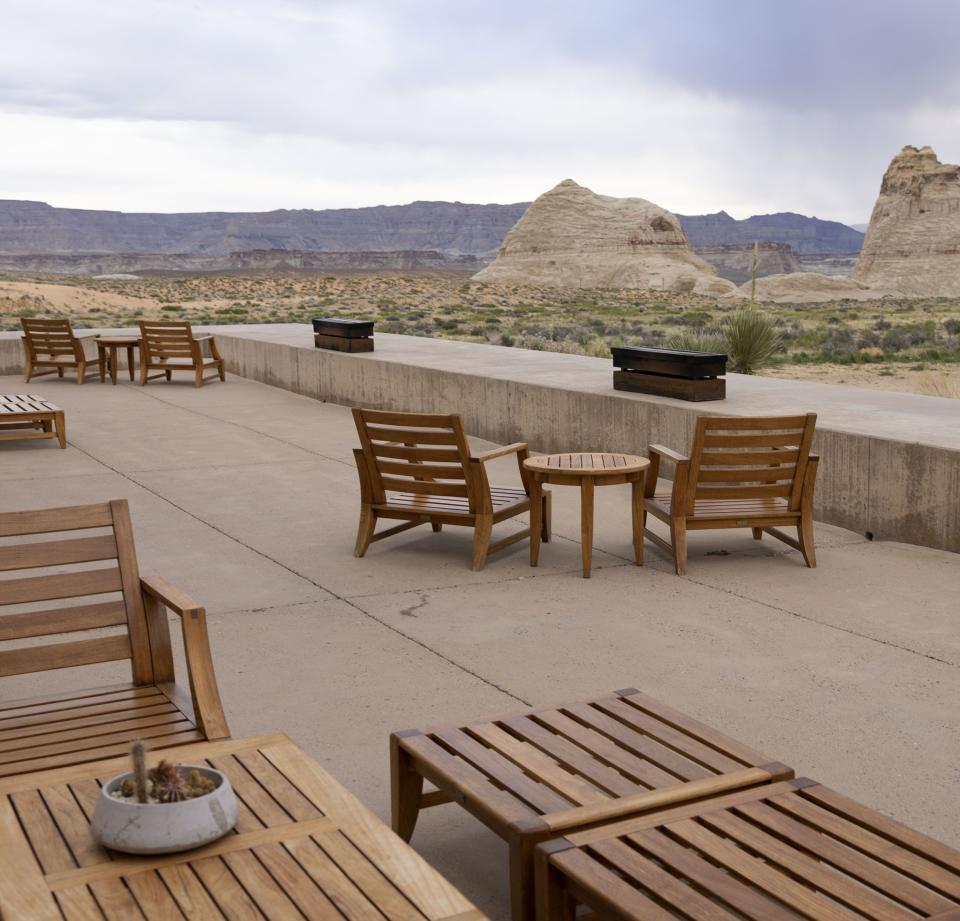
“Having lived in Asia five times, you can’t escape the popular draw of the Aman name, which was virtually unknown here” in Utah, before Amangiri, Huntsman said. So he was one of the few with decision-making power in Utah who knew anything about Aman.
At first, Huntsman said he was surprised by the proposal, then intrigued. In Asia, Aman Resorts carefully integrate native culture, and he wondered how they would pull it off in a place like Kane County, Utah. Plus, it was in the middle of the desert, with no major city anywhere close by, so he knew the logistics would be difficult.
“I thought, wow, this is really interesting. Either it’s going to be a massive failure or a huge success,” Huntsman told me.
Today, Utah is one of the fastest-growing, economically stable states in the nation. Politically, growth is more of a four-letter word than it is welcome these days. But “people forget” what it was like for Utah back then, Huntsman said. At the time, his administration was hungry for economic development opportunities and “hunting” for jobs, especially in rural areas like Kane County.
So Huntsman said he embraced plans for a future Amangiri, and he used the power of the governor’s office to convene local, state and federal officials to help pave the rest of the way for the resort.
“When (Huntsman) found out that we were actually thinking about (building) an Aman in his state, I mean he was unbelievable,” Vazifdar said. “I’ll tell you, he helped me so much in making sure we had all the power of the governor’s office and all the senators there, they all came together.”
Related
At first, Vazifdar said Wall Street thought he was crazy. When it opened in 2009, it was “in the middle of the eye of the hurricane” of the Great Recession. But now, Vazifdar said the same people that told him he was “insane” have “begged” for rooms when it’s sold out.
Amangiri wasn’t always as pricey as it is today. It started at about $800 to $900 a night, Vazifdar said. But over the years, and after Russian real estate developer Vladislav Doronin bought Aman Resorts in 2014, he “took Aman resorts to a whole new level” through social media and investment in marketing, he said. Doronin continues to own Aman Resorts today. Last year, he sought to distance himself from Russia and its invasion of Ukraine, posting on LinkedIn that he denounced the “aggression of Russia and Ukraine and fervently wish for peace.”
Amangiri has since “morphed into a very expensive resort,” he said. Now it’s a bucket-list destination for some of the most wealthy people in the world, willing to pay not just for the experience and Aman’s brand, but also for the notoriety.
Suites range from over $4,000 to more than $7,000 a night for the Amangiri Suite, which offers a private lap pool and sundeck. Typically meals, excluding alcoholic beverages, are included in the stay.
For larger amenities, particularly popular with families, Amangiri has a sister property called Camp Sarika. It’s similar to glamping — but “we don’t call it glamping,” Vazifdar insisted. They’re one- to two-bedroom, temperature-controlled canvas-topped structures that offer backyard fire pits, private pools and more space to spread out. Those run about $6,200 a night for a one-bedroom or $8,200 a night for a two-bedroom, depending on the season.
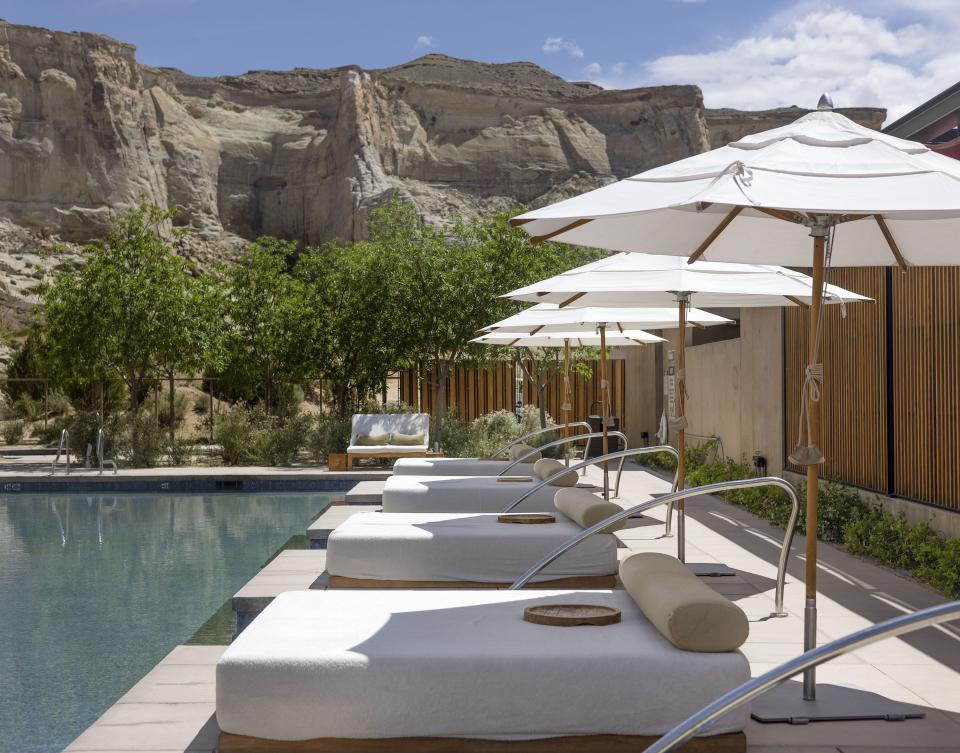
Inside Amangiri
We arrived just after sunrise, which cast the sky in a fiery orange glow on our drive from Kanab. Thick morning clouds drenched the desert in shades of gray. Everything was crisp, quiet. No guests were up yet, or perhaps barely stirring in their suites.
Friendly staff members showed us around. They pointed out the jasmine, the Navajo willows, and the almond and plum trees lining a small courtyard that filled the air with a variety of aromas. Nearby, in an area they called the “alga wall,” water seeped from the concrete, painting it with dark green shadows that sometimes bloom orange.
As we explored the spa, faint raindrops from a fleeting morning storm broke the glassy surface of the outdoor reflection pool, set at the base of swirling slabs of sandstone. The 25,000 square-foot spa offers a steam room, sauna, cold plunge pool and heated step pool, with five wood-paneled treatment rooms that open wide to the desert through double doors.
The resort is built around a central heated swimming pool, which curls around a large rock escarpment. In the afternoon sunlight, blue waters shimmer in bright contrast against the white, gray and yellow layers of sandstone. Guests lounged poolside in king-sized, umbrellaed daybeds. Servers carrying trays of colorful beverages were at their beck and call.
Our tour guides explained Amangiri’s architecture integrates all things natural — from small, square windows in the spa rooms for dim lighting, to alleyways that channel wind for natural air conditioning. The concrete was mixed using local sand. The walls mimic slot canyons and frame the surrounding landscape.
They told us the hotel’s concrete walls were all designed using straight lines, or “angular minimalism.” Except for one area. There’s only one curve on the whole property — and perhaps one unintentional flaw. At the top of a pillar outside the gym, accessed by a steep set of stone stairs, there’s a bend that’s meant to mirror the mesa in the distance behind it. At the tip of the curve, there’s a missing chunk, which multiple staff members told us was due to a recent lightning strike that cracked so loud, it terrified employees and guests.
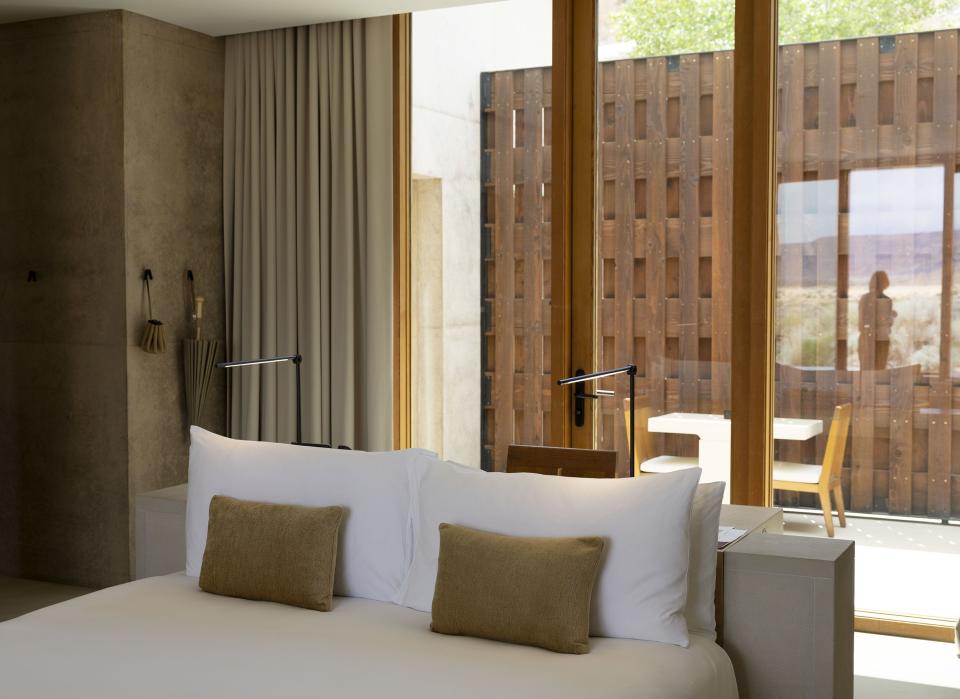
The suites are sleek, modernist and earth-toned. A raised stone island in the center of each suite cradles a king bed. Each room features large, swinging doors that open wide to the surrounding desert scenery, with cushioned benches around a private fire pit. The walls are bare, except for homey touches hanging near the door: a wooden walking stick, an umbrella, a woven hat. The roomy bathroom and dressing areas are decorated with deep green stone. A tall, narrow window centered over the bathtub provides yet another view into the sandy desert.
During our tour, we met Connie Beingessner, of Big Water, a fitness instructor who said she’s worked at Amangiri since it opened in 2009. She admitted when she first came to the site, when the first concrete was being poured, she said she honestly thought it looked “weird,” like a “bomb shelter.” But she raved about how much she loved working there.
She explained Aman’s strict privacy policies with celebrities, noting that Aman requires its staff to treat all guests with the same level of professionalism and respect, regardless of who they are. It won’t tolerate gawking. And she told us of Aman’s high expectations for employees. She fretted that she was wearing white — not black — socks according to uniform requirements, and she soon flitted off to change them.
Related
We also met Darlene Dodson, of Page, who said she’s worked at Amangiri in housekeeping for 10 years. She said she grew up on the Navajo reservation, and she appreciated that Amangiri offered jobs and opportunity to people living in the Navajo Nation.
When I asked Dodson how she felt about Amangiri using Navajo traditions in its activities and services — for example, the spa draws on Navajo healing traditions, including a sage smudge as part of its treatments — she told me she didn’t mind as long as it’s done properly and respectfully. She watches to make sure.
The resort offers a slew of activities and excursions, from motoring around Lake Powell, hiking slot canyons via ferrata fixed climbing routes, horseback riding, hot air balloon rides, helicopter tours, visits to Monument Valley Navajo Tribal Park and trips to surrounding national parks, from Bryce Canyon to Zion to the Grand Canyon.
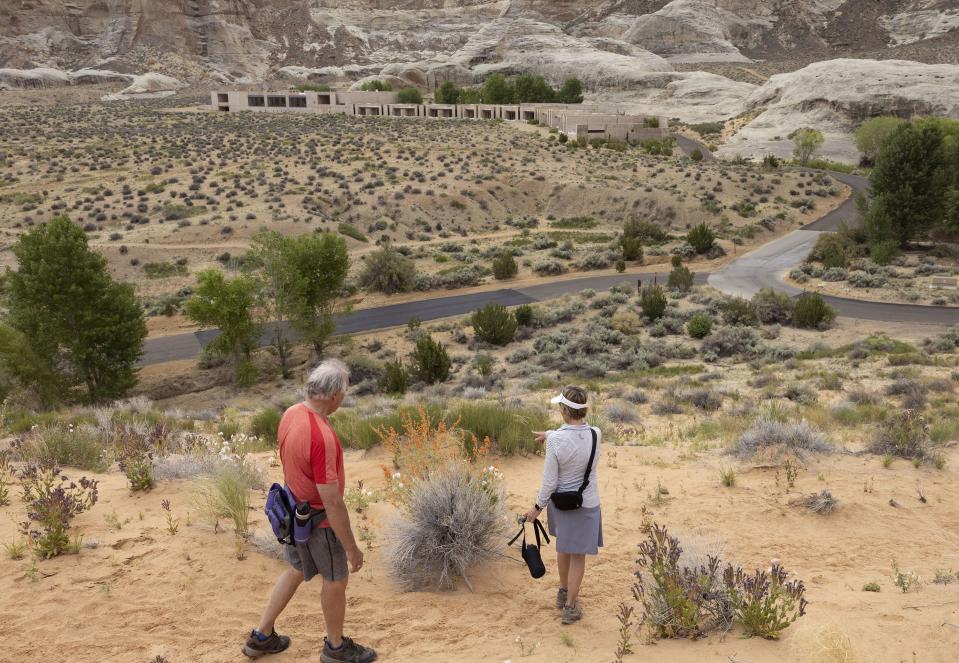
Is it worth the cost?
When we first gathered to join an early morning guided hike, Amangiri’s general manager, Audrey Huttert, gave us a strict order: Do not bother the guests. It’s Aman’s policy — its philosophy — to respect their privacy, so she did not want a reporter and a photographer to intrude.
But when we headed out, chatting among ourselves as we admired the pops of white and red desert flowers while we trudged through deep sand, some of the guests struck up conversation with us, curious what a pair of journalists were doing here. They told us they didn’t mind us speaking to or photographing them.
Among them were Salt Lake City residents Vicki and Bill Bennion. The couple was swooning over what they said was a once-in-a-lifetime vacation in a place they’d never expected.
The Bennions said the only reason they were spending two nights at Amangiri was because they won the stay after buying a couple of $100 raffle tickets at a gala fundraiser for the Natural History Museum of Utah.
Thrilled that they won, Vicki Bennion said they initially thought they’d extend the stay and pay the difference. Then they saw the $4,200 per night price tag and realized just how much they had lucked out. They decided to keep the stay to two nights.
“It’s absolutely breathtaking,” Vicki Bennion said of Amangiri. “When you see how they built this hotel right into the landscape. ... And when you’re in the property, it feels very calming, very natural. ... You feel very included in the landscape.”
Their meals and drinks, however, weren’t included in their raffle prize, and the Bennions joked the $30 margaritas were going to break their budget.
“Would we come here for $4,200? I doubt it,” Bill Bennion said. “But that’s not trying to be a jerk about it. I just don’t know that I could afford it.”
“If you’re in that category, though, I think it is worth it,” Vicki Bennion told us. “Especially if you’re in a high-profile career and you just want to get away and be calm, this would be an ideal place to come.”
For the uber-wealthy, “this would be a drop in the bucket,” Bill Bennion said.
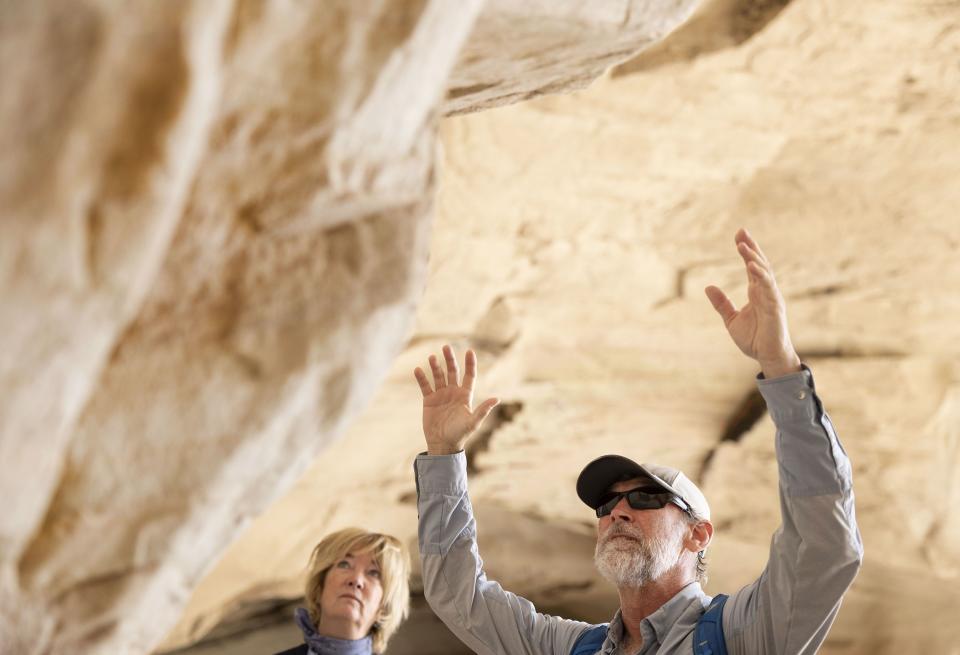
The Bennions told us this while we hiked up and around Broken Arrow Cave, carved by freezing and expanding moisture in the sandstone layers of the Entrada Formation. Our guide, Marc Woodard, said that in the late 1990s, Brigham Young University and volunteers from the Bureau of Land Management excavated a small portion of the cave and discovered evidence of human occupation dating back thousands of years.
He pointed to faint carvings, some depicting antlered creatures or spirals, saying they were likely authentic petroglyphs. But inches away on the same rock, he pointed to examples of “graffiti,” or modern-time carvings of initials, an alien head, and a UFO. “Those were here long before the hotel was built,” Woodard said.
After we hiked up a narrow, wooden stairway to the cave’s top edge, an archway framed Amangiri in the distance, barely visible at the base of the plateaus.
Another guest, Haley Hoppe, of Las Vegas, was a more seasoned Aman traveler. She said she’d been to Aman resorts in Asia, “but there’s no place like this.”
“It’s just magical,” she said, praising the resort’s activities, guides and amenities. She was particularly smitten with the nighttime stargazing. “I feel so renewed and rejuvenated when I’m here that I have to come back. ... It’s definitely one of the most special places I’ve ever been to. It’s a jewel in the U.S.”
To Hoppe, the cost is steep — but it’s worth it.
“You’re paying for an experience that is unlike any other, though,” she said. “There’s really no comparison. There’s nothing in a remote location like this.”
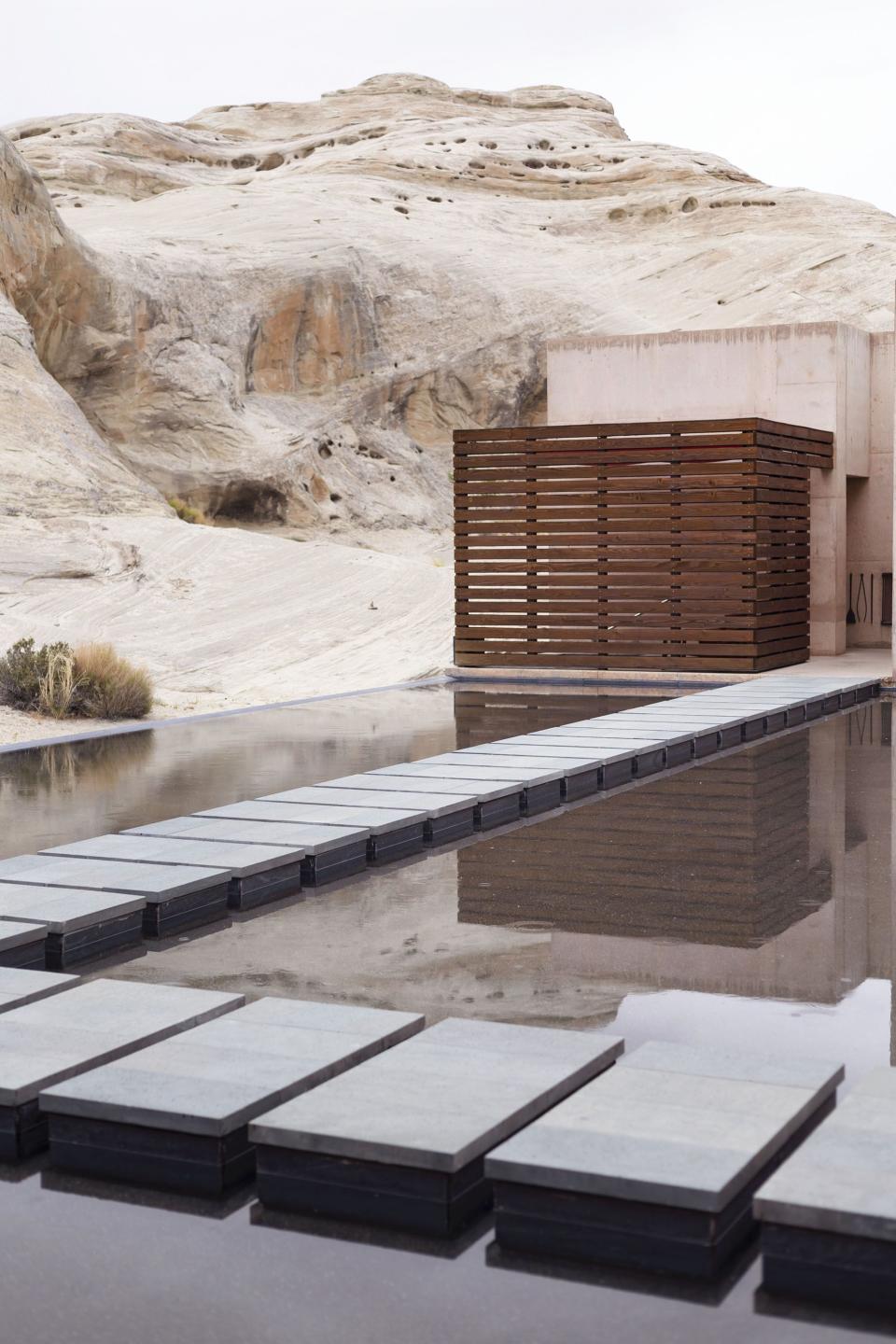
What has Amangiri brought to Utah?
When plans for Amangiri were publicly announced in 2005, Huntsman lauded the project as one that would put Kane County, Utah, on the world map along with other exotic locations around the world that host Aman properties: Thailand, Cambodia, India, Indonesia, France, French Polynesia and Mexico, among others.
In addition to economic investment, at the time he said it would also bring 150 construction and 200 permanent jobs to the rural area.
It became the second Aman resort in the U.S., behind Amangani, meaning “peaceful home,” in Jackson Hole, Wyoming. Today, Amangiri sits on a 900-acre property, nestled in those very rock formations that captured Zecha’s gaze.
Has it brought everything that was promised?
To Huntsman, it has, especially considering it was a “risk at the time for everyone involved.” Since then, it’s “upped our game as a state to be able to bring in the best of the best of the world.”
“In hindsight, I think you have to argue both parties involved are probably happy with where it is. That really is the acid test after it’s been able to settle in for more than a decade,” he said. “How do people feel about it? And I suspect that people feel pretty good about what the Aman people have done.”
Amangiri is a “good example of how a collaborative effort can really help enhance prospects for a county like Kane County,” Huntsman said.
“When you look at all of the things that you would hope for in a project like this, does it enhance people’s lives? Does it expand economic prospects for the county, which of course they were desperately after, does it do it in a way that showcases the state in an interesting, in a creative way that will help it to continue to grow? Are they good stewards of the land because that land is the most precious on Earth? I think you’d have to say yes to all of those things.”
Amangiri is indeed among the top, if not the top, property tax, sales tax and transient room tax contributors in Kane County, according to county officials, though the county assessor declined to give specific annual figures.
Kane County Commissioner Celeste Meyeres told me Amangiri alone contributed about 40% of the county’s annual transient room tax, which totals about $6 million a year, making up a “huge portion of our expendable budget.” Because about 90% of the county is federally protected land, “we have very little other industry besides tourism,” so it’s “incredibly important to our economy. It can’t be overstated.”
Amangiri, in particular, helps provide stability to the county’s budget by diversifying its tourism offerings throughout the year, regardless of whether it’s winter or summer, she said.
It’s an important economic and financial player, and employs roughly 250 to 260, on average, according to Huttert, Amangiri general manager, though not all come from Kane County or even Utah. While some employees commute from Big Water, many also come from nearby Page, Arizona, and some from Navajo Nation.
“Maybe for our county it’s not a massive job creator, but for our area it is, and the reason is because it’s such a high-end place,” Meyeres said. If Amangiri didn’t exist, neither would any of those jobs or opportunity to gain experience in luxury hospitality.
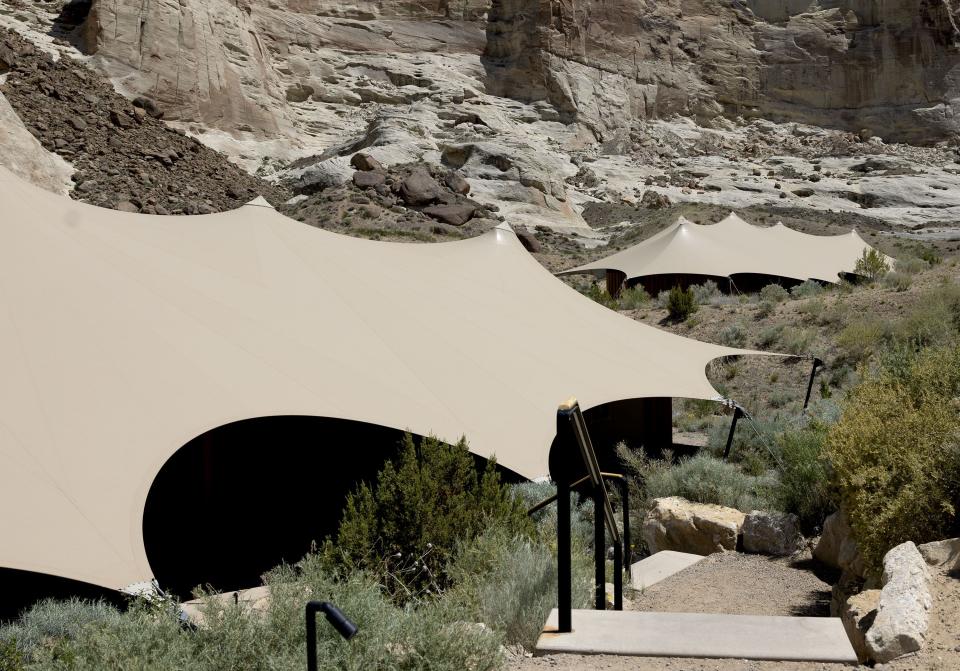
Visitor count and employees fluctuate seasonally, but between Amangiri’s 34 guest suites and 10 canvas-topped, one- or two-bedroom pavilions at nearby Camp Sarika, typically the resort hosts no more than 90 people at one time, according to Huttert.
Kane County commissioners recently toured Amangiri, Meyeres among them. When asked her impression, she said, “Beauty is in the eye of the beholder.”
“I’m like, that’s really cool. I don’t necessarily love looking out at what looks like a war compound,” referring to the resort’s concrete exterior, but she added it’s “really great that there are so many different interpretations of what desirable is.”
She noted people come from all over the globe to visit famed Zion National Park, to the point that it’s grappled with overcrowding. “It’s not at all like Zion in hardly any ways, and yet people are finding it worth traveling over the world to visit it, and that gives us hope (for Kane County). It still finds a way to be relevant.”
But there is a big trade-off that made Amangiri possible. It goes back to the literal trade, the land swap. The land that was exchanged is indeed beautiful. It was once public, but now the only people who can enjoy it are those who can afford Amangiri’s steep price.
“That’s the trade-off,” Huntsman acknowledged.
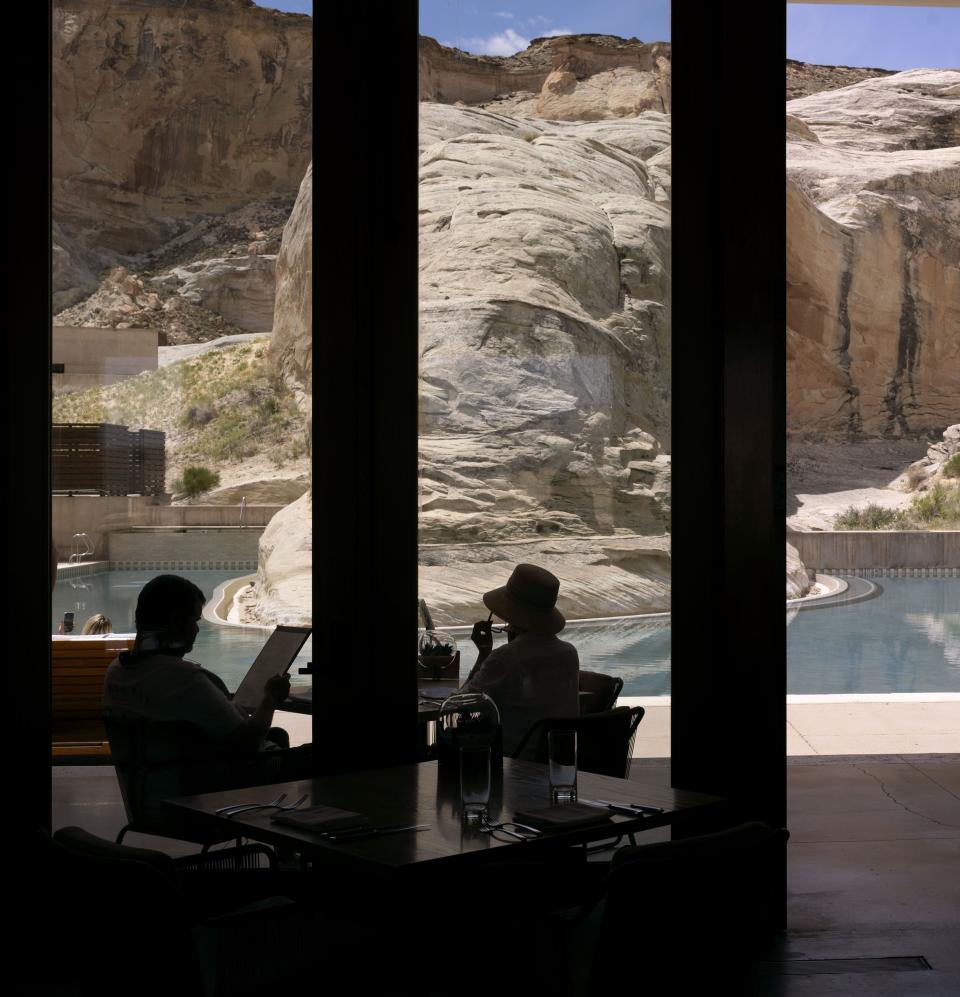
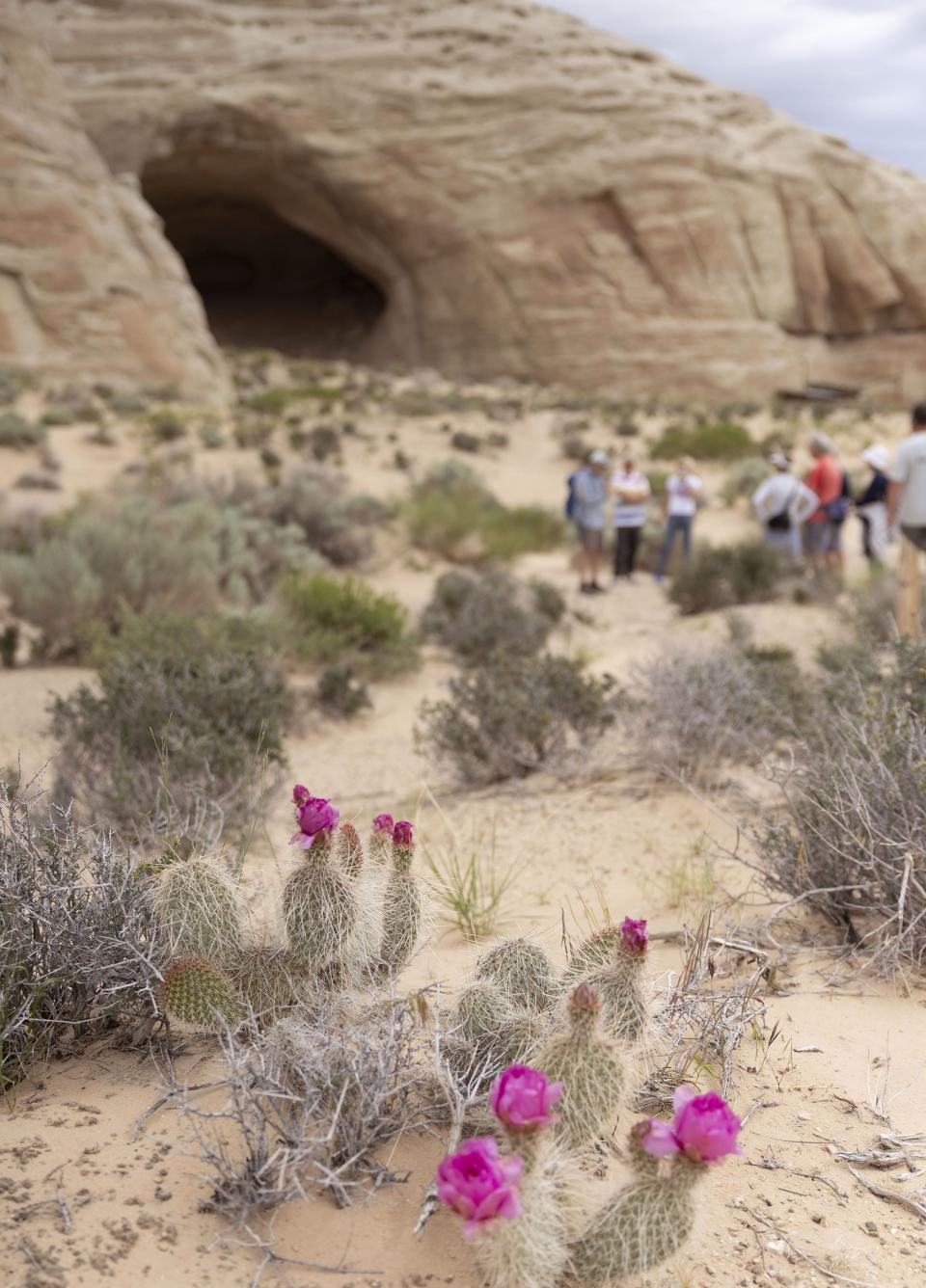
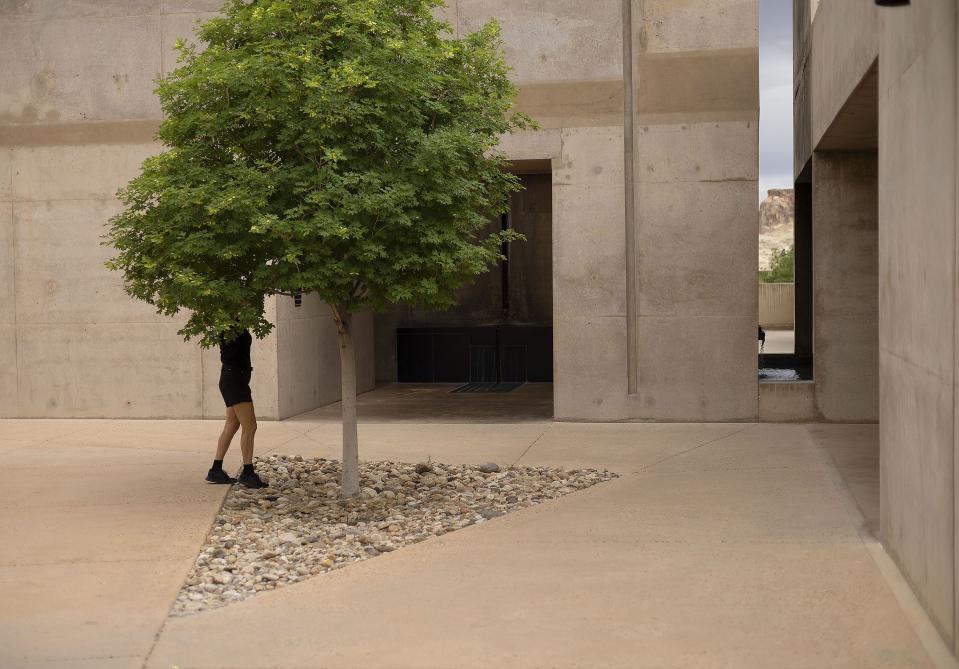
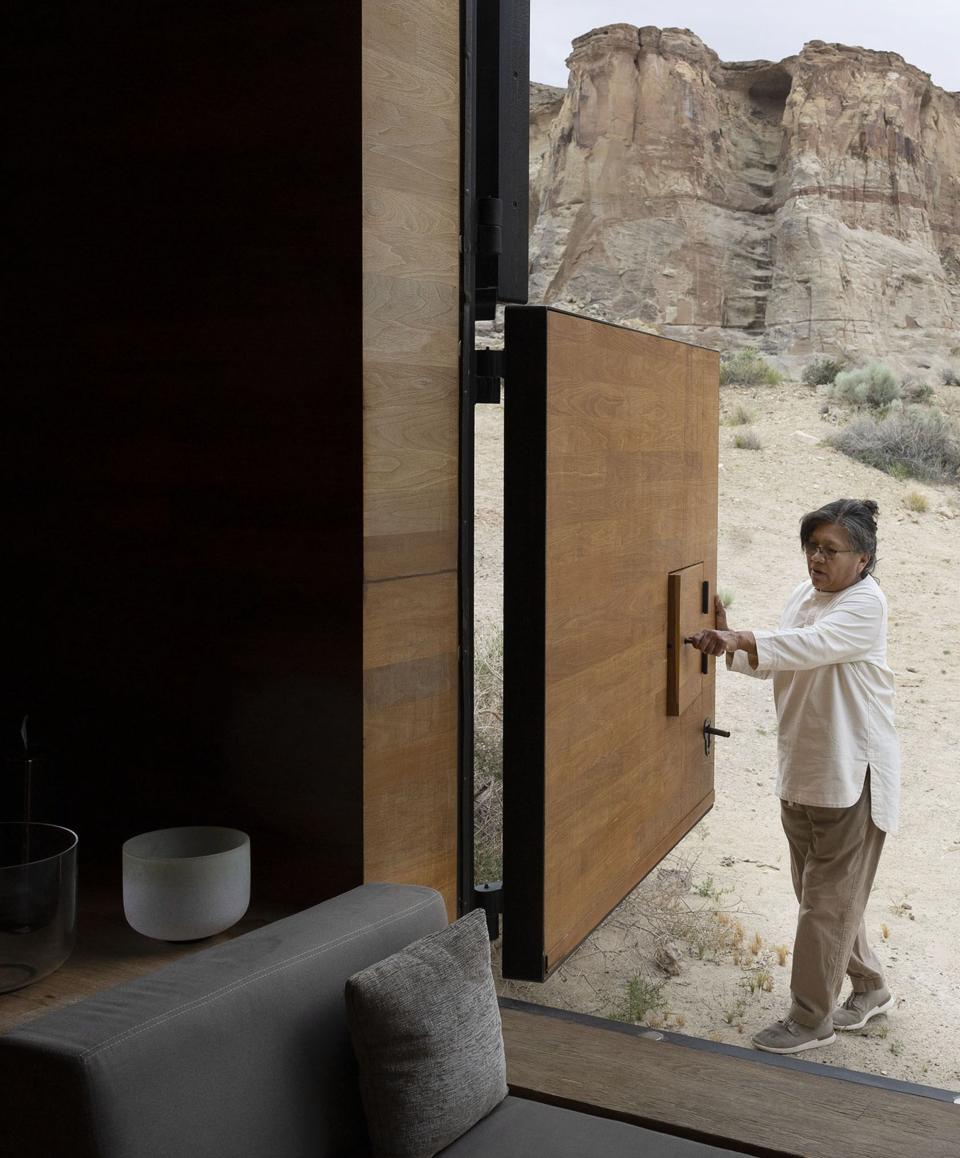
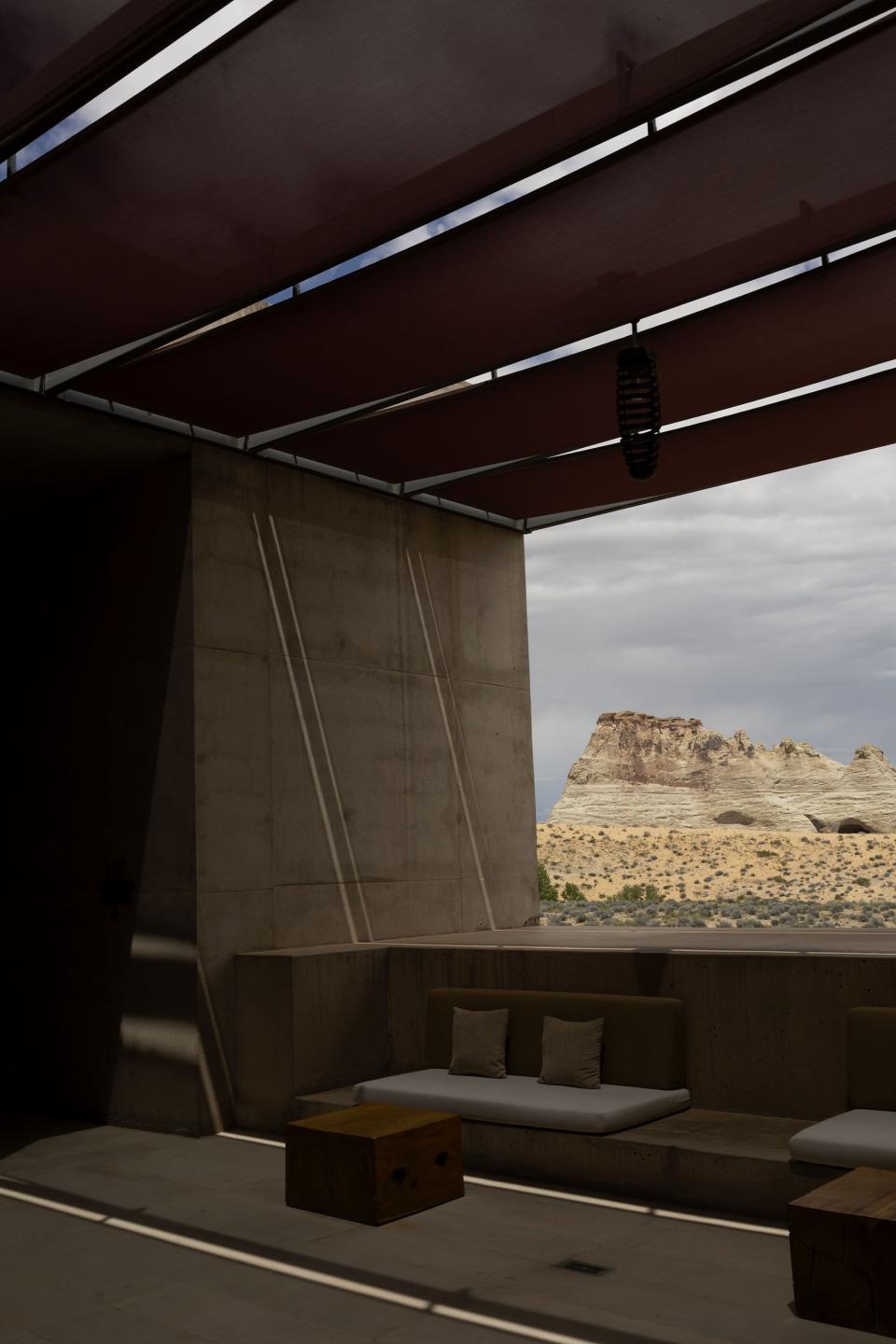
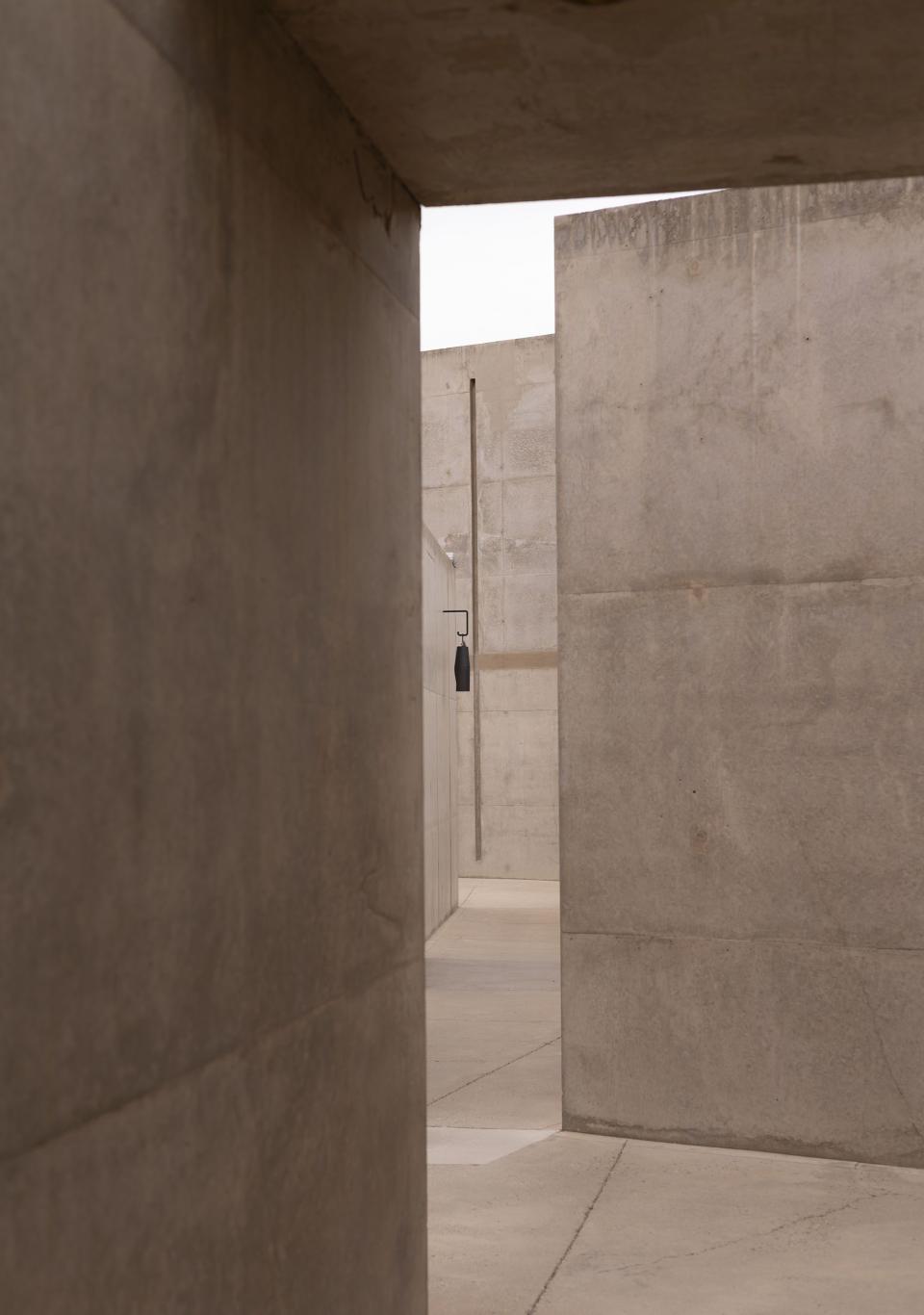
Correction: An earlier version of this story incorrectly stated Amangiri sits on 600 acres. The resort property is 900 acres.

